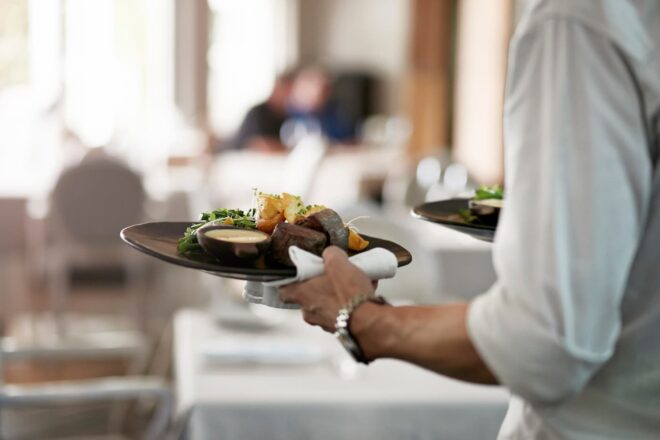The ultimate guide to pricing strategy for new businesses
Editorial Team
6 min read
Critical, but frustrating–that’s how many business owners describe the process of pricing their goods and services. Set prices too low, and revenue takes a hit. Too high, and customers might head elsewhere. So, how do you find the sweet spot?
This handy guide from Clover delivers insights into pricing strategies and how they impact profit margins and growth. Use our guide to compare the pros and cons of price-setting methodologies. Then, leverage those resources to make informed decisions that serve your current–and future–business goals.
What is a pricing strategy?
When deciding what to charge for their products and services, most business owners rely on a specific methodology or process to guide them–a pricing strategy. Depending on your business type (typically retail, services, or food and beverage), some methods will feel more relevant to you than others.
Feel free to test-drive any of these strategies before settling on your favorite.
Compare pricing methodologies
Remember, shrewd pricing will help drive demand for your products and services. Sales figures tell part of the story and can reveal whether your prices are set effectively. Read more about the most common pricing methodologies below:
Targeted return pricing
This is a cost-based strategy of setting prices based on a specific return-on-investment (ROI) goal. For example, if you want to recoup the startup and operating costs for your first year, annual sales must equal those costs (break-even pricing). To make a profit, your sales need to reach that break-even amount and then some.
Say you spend $10,000 to stock bottles of handcrafted beard oil in your new shop. The same formula applies whether it’s brick and mortar, virtual, or hybrid. Operational costs reach an additional $15,000 for the first year. Your product costs $3.00 to make. If you set the retail price at $10.00, that’s a whopping profit of $7.00 per unit! Of course, you need to sell 3,571 units at $10 each just to break even. To turn a profit, either set your price higher or sell more units.
Should inflation come into play, the cost of producing your beard oil could increase. Plus, you might be forced to lower prices to counter sluggish sales.
Cost-plus pricing
Also known as markup pricing, the cost-plus methodology sets your selling price based on a fixed percentage of the cost of producing the item. Imagine you’re selling frozen empanadas that cost $1.20 to make. A markup of 40% means the empanadas’ retail price would be $1.68. The trick is finding a formula that delivers enough profit for your business to thrive.
Keystone pricing
A subset of cost-plus pricing, this method sets your retail price at precisely double the wholesale price. If you purchase beaded handbags for $15 wholesale, you must sell them to customers at $30. The profit margin would be an attractive 100% of the cost price. Before the digital transformation, the Keystone method worked reasonably well for retailers. But eCommerce makes it nearly impossible for a small business to double a wholesale price. Too easy for consumers to search online and find the same goods for less.
Competitive pricing
If you’ve identified the going rate for products and services similar to yours, you’ve taken the first step in competitive pricing. This strategy involves leveraging what you know about the competition to price similar offerings slightly below or even above theirs.
Let’s say you’re starting a lawn care service. If your competitors charge $45 – 70 hourly, you could attract customers by pricing your service at $55 per hour, which is neither too “cheap” nor too expensive. Clients may gravitate from others to your business because they perceive your pricing as fair for comparable service.
Value-based pricing
Here’s a pricing strategy based on your knowledge of what customers are willing to pay. Unlike the cost-plus method, there’s no simple formula for determining value-based pricing. Before setting prices, you need to study your market closely, analyze the competition’s strategies, and gather as much buyer insight as possible.
Value-based is not a pricing strategy for mass-produced goods, but it could work if your offerings are one-of-a-kind or handmade. Luxury items tend to do well with value-based pricing because they are so differentiated from everything mass market. The downside is that this market is less stable, and you may have difficulty raising prices on goods already priced at a premium.
Penetration pricing
For businesses arriving late to a crowded market, penetration pricing may give you an edge. Customers are attracted to items of similar value that cost less money. Your products can stand out if you offer them at a substantial discount compared to a market filled with similar products.
For example, many online vendors sell customizable stickers. To boost sales, your shop could offer custom stickers with an extra, like an introductory discount, free shipping, or a BOGO promotion. With penetration pricing, you’ll reach customers who care less about the brand if they can get the same quality products at lower prices.
Menu price-setting for food & beverage businesses
Food and Beverage entrepreneurs may encounter these challenges related to menu pricing-setting concerns:
1. Competitive environment
Does research show similar companies nearby? Sharpen your competitive edge with these strategies:
- Underpricing or running promotions
- Offering a wider range of choices
- Enhancing customer experience
- Being flexible: providing dine-in and delivery services
2. Food costs
Setting prices for high-end beef and seafood can be challenging when supply and market prices fluctuate. You may need to adjust your menu prices frequently. To offset the impact of those price changes, try balancing the menu with consistently-priced items such as pasta or chicken dishes.
3. Standardized portions
In Food & Beverage, controlling portions is another facet of pricing strategy. Ensure that your ingredients are standardized by monitoring their weight, count, and measurements. Precise, consistent portions help you control waste and other costs while improving financial projections.
READ: How to calculate your restaurant’s food costs
Final thoughts on pricing strategy
Business trends like inflation, supply chain security, and sustainability can also impact your decisions. Whichever pricing strategy you select, keep these points in mind:
Research is your friend. Knowing what you don’t know is a tremendous business asset when starting. Gather competitive information, study business models, and crunch your numbers to optimize your pricing strategy. If necessary, you can outsource market research to a professional firm while you focus on other priorities.
You deserve a salary. Launching a new business involves personal risks that you shouldn’t undertake without compensation. Aim for a profit margin that is realistic, but do not short-change yourself.
Customers determine the value. Pricing your offerings with precision is essential. But ultimately, those products and services are only worth what consumers will pay.
To learn how you can use Clover POS systems to help ease the pricing process, contact a Clover Business Consultant today.
CONTACT SALESRelated Posts
Full Service Restaurants (FSR)
Should your restaurant switch to a no-tipping policy?
Transform your shipping process
Popular Topics
Stay in touch
Sign up and learn more about Clover.
Thank you for your subscription!
More posts about starting a small business
eBook
Retail roadmap: Financial goal-setting for the year ahead
Please share your contact information
to access our premium content.
Thank you for sharing your contact information.
Download Now





